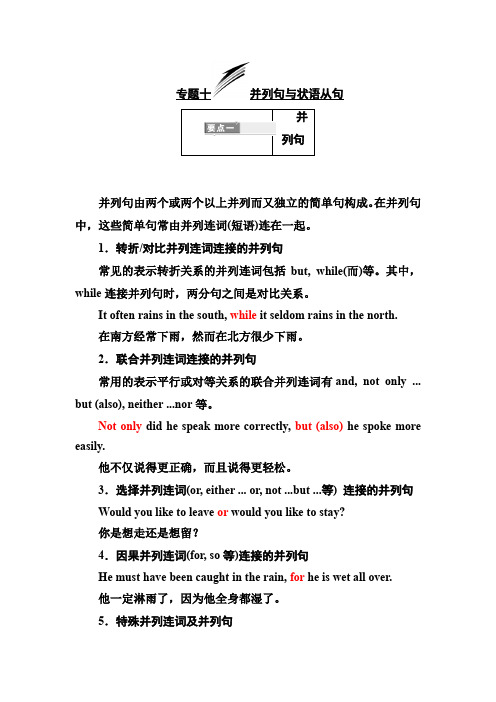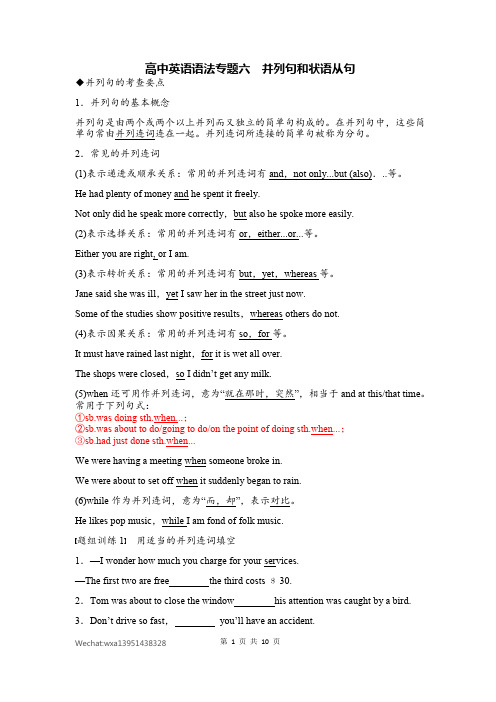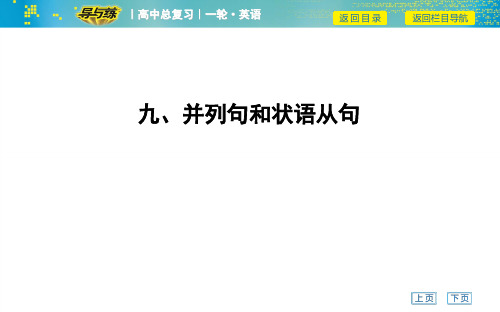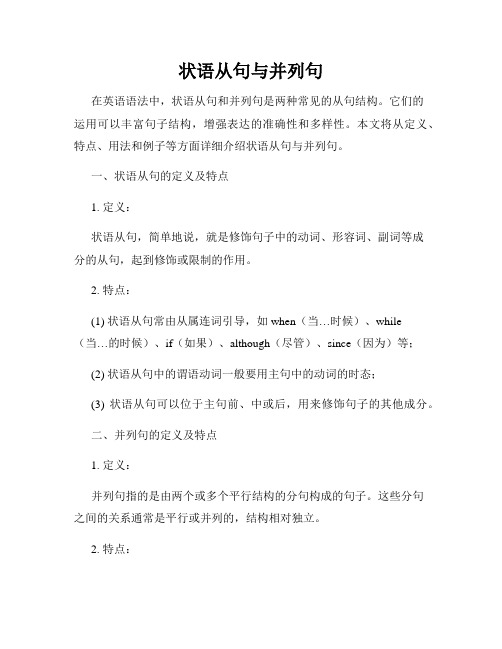高中英语语法——并列句和状语从句
高三英语一轮复习语法第10讲并列句和状语从句讲义

高中英语语法第10讲并列句和状语从句及稳固练习考点一并列句并列句由两个或两个以上并列而又的简洁句构成。
在并列句中,这些简洁句常由并列连词(短语)连在一起。
这/那时,突然……〞,常用于以下句式:sb be about to do/going to do/on the point of doing sth when...(某人刚要做某事,突然……), sb be doing sth when...(某人正在做某事,突然……), sb had (just) done sth when...(某人刚做完某事,突然……)。
He was about to go out when the telephone rang.他刚要出去时,铃响了。
He had just finished writing a report when the boss let him type a letter.他刚写完一篇报告,老板就让他打一封信件。
考点二状语从句(1)连词before的句型及意义:It will be some time (一段时间)+before ...,意为“多久以后才……〞;It won't be some time (一段时间)+before ...,意为“用不了多久就会……〞。
(2)连词since的句型及意义:It is some time (一段时间)+since引导的时间状语从句=It has been some time (一段时间)+since引导的时间状语从句,意为“自从……以来已经多长时间了〞。
(3)whether...or...意为“无论……还是……〞,引导让步状语从句。
(4)where引导地点状语从句。
稳固练习①.单句语法填空1.(2021·全国甲卷)We hired our bikes from the rental place at the South Gate. My bike was old and shaky but did the job.解析考查连词。
高考英语语法-并列句和状语从句,题型全覆盖

高考英语语法-并列句和状语从句,题型全覆盖Ⅰ. 单句语法填空1.Lessons can be learned to face the future __though/although__history cannot be changed.解析:对比分析两个句子的意思可知从句表达的意思是“虽然;尽管”。
句意为:虽然历史不能被改变,但是可以学习经验来面对未来。
设空处引导让步状语从句,故填though/although。
2.You will never gain success __unless__you are fully devoted to your work.解析:根据句意可知主从句间是条件关系,且对比分析两句话间“主将从现”的时态及主句中的否定词never可知用表条件的unless(if...not)。
句意为:除非你完全投入到你的工作中,否则你永远无法取得成功。
3.He is a shy man,__but__he is not afraid of anything or anyone.解析:but用来连接并列但语义对比的两个句子。
句意:他是个腼腆的人,但他并不怕任何事或任何人。
4.__Once__the damage is done, it will take many years for the farmland to recover.解析:once一旦。
句意:一旦造成损害,土地要好多年才能恢复。
5.We need to get to the root of the problem__before__we can solve it. 解析:本题考查状语从句的连词。
before表示“主句发生在从句之前”。
句意:在我们解决问题之前,我们需要找到问题的根源。
6.__Although/Though__the job takes a significant amount of time,most students agree that the experience is worth it.解析:although/though虽然(表示“虽然”时,不在后面使用连词but,不过有时它可与yet,still,nevertheless等副词连用)。
高中英语语法:并列句和状语从句

高中英语语法:并列句和状语从句常见的并列连词1. and和or◆and的用法如下:(1) 表示另加:其意为“和”“又”“而且”。
如:☞Let me have some toasts and a cup of coffee. 给我来几片烤面包和一杯咖啡。
(2) 表示结果:意为“因此”,与so的用法比较接近。
如:☞He fell heavily and broke his arm. 他摔得很重,手臂都摔断了。
(3) 表示条件:相当于if…then,含有“如果……那么……”的意味。
如:☞Do that again and I’ll call a policeman. 你再这样做我就要叫警察了。
(4) 表示连续:既可表示一种连续不断的状态,也可以表示一个动作完成之后连续做另一个动作。
如:☞The train ran faster and faster. 火车开得越来越快。
☞He finished lunch and went shopping. 他吃完午饭而后去买东西。
(5) 表示对比:含有“尽管……还”的意味。
如:☞Tom’s 15 and still sucks his thumb. 汤姆15岁了,还嘬大拇指。
◆并列连词or要比and用法简单此,它主要表示选择,其意为“或”“还是”等。
如:☞It’s a lovely baby. Is it a boy or a girl? 宝宝真可爱,是男孩还是女孩?☞He speaks French, or perhaps he understands it. 他会讲法语,或者他懂法语。
另外,or还可以表示一种否定的条件,相当于if…not…如:◆Be careful, or you’ll break that vase! 小心,否则你会把那花瓶打碎。
=If you don’t be careful, you’ll break that vase.2. 表对比或转折的连词主要有but和yet(1) but的用法:其意为“但”“但是”“却”。
高考英语考点汇总并列句和状语从句

并列句和状语从句一、并列连词1.表示并列关系的连词:and: 可用来连接两个或两个以上的单词/短语或句子,表示一种顺接的关系。
☞He helps me and I help him. 他帮我,我帮他。
both…and:"两个都……",连接两个并列主语时谓语动词用复数。
☞Both Li Ping and Mary are going to the Great Wall tomorrow.neither…nor: "既不……也不……",连接的并列成分可在句中作主语、表语、宾语等。
连接并列成分作主语时,谓语动词通常与nor后的部分保持一致。
☞Neither he nor I am right.not only…but also: "不仅……而且……",强调后者;引导并列主语时,谓语动词与后面的主语保持一致。
☞Not only the students but also the teacher gives the money to our school.2. 表示选择关系的连词:or:用于否定句中连接并列成分,表示"和,与";用于"祈使句+or+陈述句"中,意为"否则,要不然"。
☞The baby is too young. He can’t speak or walk.either…or…:"要么……要么",连接的并列成分可在句中作主语、表语、宾语等。
连接并列成分作主语时,谓语动词通常与or后的部分保持一致。
☞Either Tom is ing or his sisters are. 不是汤姆就是她的姐妹们要来。
3. 表示转折关系的并列连词4. 表示因果关系的并列连词for :so : 4. when 可作并列连词,意为“正在这时”,表示某件事正在发生或刚刚发生时,突然发生另一动作。
⎩⎪⎨⎪⎧ be about to do...when...be doing...when...be on the point of doing...when...had just done...when...☞Tom was about to close the window when his attention was caught by a bird.汤姆正要关窗户,这时他的注意力被一只鸟吸引住了。
【高考英语语法专题】专题十 并列句与状语从句

专题十并列句与状语从句并并列句由两个或两个以上并列而又独立的简单句构成。
在并列句中,这些简单句常由并列连词(短语)连在一起。
1.转折/对比并列连词连接的并列句常见的表示转折关系的并列连词包括but, while(而)等。
其中,while连接并列句时,两分句之间是对比关系。
It often rains in the south, while it seldom rains in the north.在南方经常下雨,然而在北方很少下雨。
2.联合并列连词连接的并列句常用的表示平行或对等关系的联合并列连词有and, not only ... but (also), neither ...nor等。
Not only did he speak more correctly, but (also) he spoke more easily.他不仅说得更正确,而且说得更轻松。
3.选择并列连词(or, either ... or, not ...but ...等) 连接的并列句Would you like to leave or would you like to stay?你是想走还是想留?4.因果并列连词(for, so等)连接的并列句He must have been caught in the rain, for he is wet all over.他一定淋雨了,因为他全身都湿了。
5.特殊并列连词及并列句(1)when可用于并列连词,意为“这时,那时”,相当于and at this/that time。
常用于下列句式:①be about to do sth. when ...“正要做某事,这时突然……”②be on the point of doing sth. when ...“正要做某事,这时突然……”③be doing sth. when ...“正在做某事,这时突然……”④had done sth. when ...“刚做了某事,这时突然……”He was about to go to school when a strong wind began to blow.他正要去上学,这时突然刮起了大风。
06高中英语语法专题 并列句和状语从句

高中英语语法专题六并列句和状语从句◆并列句的考查要点1.并列句的基本概念并列句是由两个或两个以上并列而又独立的简单句构成的。
在并列句中,这些简单句常由并列连词连在一起。
并列连词所连接的简单句被称为分句。
2.常见的并列连词(1)表示递进或顺承关系:常用的并列连词有and,not only...but (also)...等。
He had plenty of money and he spent it freely.Not only did he speak more correctly,but also he spoke more easily.(2)表示选择关系:常用的并列连词有or,either...or...等。
Either you are right, or I am.(3)表示转折关系:常用的并列连词有but,yet,whereas等。
Jane said she was ill,yet I saw her in the street just now.Some of the studies show positive results,whereas others do not.(4)表示因果关系:常用的并列连词有so,for等。
It must have rained last night,for it is wet all over.The shops were closed,so I didn’t get any milk.(5)when还可用作并列连词,意为“就在那时,突然”,相当于and at this/that time。
常用于下列句式:①sb.was doing sth.when...;②sb.was about to do/going to do/on the point of doing sth.when...;③sb.had just done sth.when...We were having a meeting when someone broke in.We were about to set off when it suddenly began to rain.(6)while作为并列连词,意为“而,却”,表示对比。
【英语语法】并列句和状语从句

九、并列句和状语从句
语法专项·精讲 跟踪训练·运用
︱高中总复习︱一轮·英语
语法专项·精讲
一、并列句 考点一 常见并列句的类型及并列连词
细筛选·巧拓展
类型
并列关系 (递进关系)
转折或 对比关系
选择关系
因果关系
并列连词 and,both...and...,not only...but also...,neither... nor...等
答案及剖析: 3.but→and “我计划每两年回乡下的爷爷奶奶家一次”与“他同意了”是 顺承关系,不表示转折,故将but改为and。 4.and→or 连词使用错误。主语是Everyone,因此his与her之间为选择关系, 而非并列关系,故用or。
︱高中总复习︱一轮·英语
跟踪训练·运用
重实效·冲高考
连词 when while
含义及用法
“当……时候”,可与延续性 动词或短暂性动词连用;从句 动作可以发生在主句动作之前 、之后或与主句动作同时发生
“当……时候”,一般只可与 延续性动词连用,从句动作与 主句动作同时发生
例句
When you apply for a job, you must present your certificates. 当你申请工作时,你必须递交你 的有关证件。
2.Corn uses less water
rice and creates less fertilizer (化
肥) runoff.(2018全国Ⅱ)
答案及剖析: 1.than 这里是将跑步和其他运动方式作对比,再由上文的more effective 可知,此处用than。 2.than less是little的比较级,than引出比较对象。
状语从句与并列句

状语从句与并列句在英语语法中,状语从句和并列句是两种常见的从句结构。
它们的运用可以丰富句子结构,增强表达的准确性和多样性。
本文将从定义、特点、用法和例子等方面详细介绍状语从句与并列句。
一、状语从句的定义及特点1. 定义:状语从句,简单地说,就是修饰句子中的动词、形容词、副词等成分的从句,起到修饰或限制的作用。
2. 特点:(1) 状语从句常由从属连词引导,如when(当…时候)、while (当…的时候)、if(如果)、although(尽管)、since(因为)等;(2) 状语从句中的谓语动词一般要用主句中的动词的时态;(3) 状语从句可以位于主句前、中或后,用来修饰句子的其他成分。
二、并列句的定义及特点1. 定义:并列句指的是由两个或多个平行结构的分句构成的句子。
这些分句之间的关系通常是平行或并列的,结构相对独立。
2. 特点:(1) 并列句中的分句之间一般用逗号或并列连词连接,如and(和)、but(但是)、or(或者)等;(2) 并列句中的分句通常要保持结构平行,包括时态、语态、语气等方面的平行。
三、状语从句的用法及例子1. 时间状语从句:时间状语从句用来表示动作发生的时间,常由when、while、before、after、since等引导。
例子:- I will call you when I arrive at the airport.(当我到达机场时,我会给你打电话。
)- She was watching TV while her mother was cooking.(她妈妈在做饭的时候,她在看电视。
)2. 条件状语从句:条件状语从句用来表示主句动作发生的条件,常由if、unless、on condition that等引导。
例子:- If it rains tomorrow, we will stay at home.(如果明天下雨,我们会待在家里。
)- You can go outside unless it is too cold.(除非天气太冷,你可以出去玩。
- 1、下载文档前请自行甄别文档内容的完整性,平台不提供额外的编辑、内容补充、找答案等附加服务。
- 2、"仅部分预览"的文档,不可在线预览部分如存在完整性等问题,可反馈申请退款(可完整预览的文档不适用该条件!)。
- 3、如文档侵犯您的权益,请联系客服反馈,我们会尽快为您处理(人工客服工作时间:9:00-18:30)。
第12讲并列句和状语从句两个或两个以上的简单句用并列连词连在一起构成的句子叫做并列句,其基本结构是“简单句+并列连词+简单句”。
并列连词有:and, but, or, so等。
状语从句是在句子中起副词作用的句子。
根据状语从句在句中不同的作用可分为:时间、地点、原因、目的、结果、条件、方式、让步和比较状语从句。
并列连词和从属连词是高考的重要考点之一,在语法填空中通常以无提示词的方式进行考查,在短文改错中主要考查并列连词和从属连词的误用。
并列句和状语从句的考点如下:核心考点01考查并列连词并列连词是用来连接两个或多个并列的词、短语或句子的词,主要表示并列、选择、转折、因果等关系。
并列连词在句子中位置比较固定,必须位于所连接的并列单位之间;两个并列连词不能并用。
1.表示并列关系的连词表示并列关系的连词有and, both...and...,not only...but also...,neither...nor...等。
2.表示选择关系的连词表示选择关系的连词有or, either...or...等。
3.表示转折关系的连词表示转折关系的连词有but, yet, while等。
4.表示因果关系的连词表示因果关系的连词有for,so。
We listened eagerly, for he brought news of our families.5.when作并列连词的用法when除了作从属连词,引导时间状语从句外,还可作并列连词,其意义为“这时,那时”,相当于and at this/that time。
常用于下列句式:①sb. was doing sth. when...②sb. was about to/going to do sth. when...③sb. was on the point of doing sth. when...④sb. had just done sth. when...。
如:We were having a meeting when someone broke in.我们正在开会,这时有人闯了进来。
6.while作并列连词的用法while除了作从属连词,引导时间状语从句外,也可作并列连词,意为“而, 却”,表示对比。
如:He likes pop music, while I am fond of folk music.他喜欢流行音乐, 而我喜欢民间音乐。
I like playing the piano while my sister likes playing the violin.我喜欢弹钢琴,而我妹妹喜欢拉小提琴。
典例分析1(2017 北京卷)—Peter, please send us postcards_________ we’ll know where you have visited.—No problem.【解析】句意:——彼得, 请给我们邮寄明信片, 这样我们就能知道你参观过哪些地方。
——没问题。
根据句意可知,第一句中前后两个分句为因果关系, 所以填so。
【答案】so典例分析2He is a shy man, _________he is not afraid of anything or anyone.【解析】句意:他是一个腼腆的人,但是他不惧怕任何人和任何事。
根据前后句意可知,这里需要一个表示转折关系的连词。
【答案】but典例分析3You have to move out of the way_________ the truck cannot get past you.【解析】句意:你得让让路,不然卡车过不去。
根据句子结构和句意可知,空格处应该用or,表示一个否定的条件,意为“不然的话”。
【答案】or典例分析4Our rooms hadn’t been reserved for that week, _________for the week after.【解析】句意: 我们的房间预订的不是那一周,而是后一周。
根据前面的hadn’t判断, 本空填but; not...but...“不是……而是……”。
【答案】but典例分析5There were many people waiting at the bus stop,_________ some of them looked very anxious.【解析】句意:很多人在公交车站那里等着,他们中一些人看上去很焦躁。
空格前后是两个句子,而且表示两种并列的状况,所以要用and连接。
【答案】and典例分析6Give me a chance,_________ I’ll give you a wonderful surprise.【解析】句意:如果你给我一个机会,我会给你一个惊喜。
此处为“祈使句+and+简单句”结构。
【答案】and状元提醒祈使句加and, or引导的并列句表示条件。
Study hard, or you will fail the exam.好好学习,不然的话会考试不及格。
Stand up and you’ll see farther.如果站起来,你就会看得更远。
核心考点02考查时间状语从句时间状语从句通常由从属连词when,while,as,till/until,not... until...,since,before,whenever,after,as soon as,hardly…when…,no sooner…than…,once等引导。
作答相关的试题时,一定要根据上下文所提到的动作或事件的先后关系来判断。
1. 名词词组引导时间状语从句名词词组every time,the next time,the moment,the instant等,也可起从属连词的作用,引导时间状语从句。
I thought her nice and honest the first time I met her.我第一次见她就对她印象很好并认为她很诚实。
I found myself in an entirely new world the moment I arrived in Beijing.我一到北京就感到耳目一新。
2. 副词用作连词引导的时间状语从句instantly, immediately,instantly,directly, presently等也可起从属连词的作用,引导时间状语从句,表示"一……就……"的意思。
The young lady rushed into the room immediately she heard the noise.那位年轻女士一听到响声就冲进房间。
Directly he came in,he knew something had happened.他一进来,就知道出了什么事了。
3. when, while和as的区别(1) when可以和延续性动词连用,也可以和短暂性动词连用;而while和as只能和延续性动词连用。
Sorry, I was out when you called me. 对不起,你打电话时我刚好外出了.Strike while the iron is hot.趁热打铁The students took notes as they listened. 学生们边听课边做笔记.(2) when从句的谓语动词可以在主句谓语动作之前、之后或同时发生;while和as从句的谓语动作必须是和主句谓语动作同时发生。
When he had finished his homework, he took a short rest.当他完成作业后,他休息了一会儿。
When I got to the airport, the guests had left.当我赶到飞机场时,客人们已经离开了。
(3) 当主句、从句动作同时进行,从句主要表示主句动作发生的背景或条件时,只能用as,意为“随着……”;“一边……,一边……”。
The atmosphere gets thinner and thinner as the height increases.随着高度的增加,大气越来越稀薄。
(4) 如果主句表示的是短暂性的动作,而从句用延续性动词的进行时表示在一段时间内正在进行的动作,when/while/as可换用。
When/While/As I walking in the street, I saw a friend of mine.我在街上走的时候,看到了一位朋友。
4. till, until和not…until的用法(1)till和until用于肯定句中,和延续性动词连用,意为“直到……为止”,表示该动作或状态的终止时间。
(till和until作介词的用法相同)She stood there until he had passed out of sight.她站在那里直到他从视线里消失。
(2)till和until用在否定句中,常和非延续性动词连用,意为“直到……才……”,表示动作的开始时间。
The Olympic Games, first played in 776 B.C., did not include women players until it was held in 1912.奥林匹克运动会第一次举办是在公元前776年,直到1912年才有女选手参赛。
注意:until可以用在句首,till不可以用在句首。
Until you told me, I knew nothing about it.直到你告诉我,我才知道这件事情。
5. since和before的用法比较(1)since引导的时间状语从句,从句谓语动词是延续性动词的时候,理解为某动作的终止,如果从句谓语动词是非延续性动词的时候理解为某个状态的开始。
It is three years since he became a teacher.他当教师已经三年了。
It is three years since he was a teacher.他不当教师已经三年了。
(2)before引导的时间状语从句它可翻译为:“还未……就……”,“……才……”,“还没来得及……就……”等。
He walked out of the room before I could say a word.我还没来得及说一句话他就走出了房间。
③与before和since相关的句型It is+一段时间+since…(过去时). 自从……以来……It will be+一段时间+before…(一般现在时). 要过多长时间才……It was+一段时间+before…(一般过去时). 过了……才……It will be +not+一段时间+before…. 过不了多长时间……就……It wasn’t+时间段+before…(一般过去时). 过……之后就……It is 30 years since he joined the revolution. 他参加革命己三十年了。
